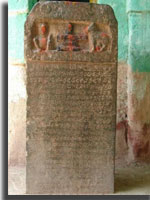History :
The Rashtrakuta Dynasty ruled south India i.e. Karnataka from 725 -985 A.C.E. The word Rastra in Sanskrit means region and kuta indicates Chieftains. They were chieftains in central India before becoming a ruling dynasty. They had good command and contribution towards art and architecture which was unique during this period. They ruled between 6th to 13th centuries. The dynasty ruled from Malwas region in Manpur today Madhya Pradesh. And in Achalapur which is modern Elichpur in Maharastra and also in Kannauj were all the Rashtrakuta Clans. The dynasty realm spread virtually over most of Maharastra, Karnataka and Andhra Pradesh.

Krishna -I (756-774) CE Dantidurga's uncle took up the throne for budding the Rashtrakuta Empire by overpowering the last king of Chalukyas of Badami Kirtivarman-II. The evidence was the copper plate grant cited from the Gujarat Rashtrakuta kind Karka from Baroda. He acquired the titles of Akalavarasha, Shirvallaba, Shubatunga and Prithivivallaba.
Govinda - II (774-780) Govinda succeded the throne from his father Krishna -I and he identified his incursion of Vengi and the defeat of Eastern Chalukya kind Vishnuvardhana IV. And then his younger brother Dhruva took over the majority of the realm by overpowering. Krishna -I bid adieu to the government and restored the position to Dhruva Dharavarsha also called as Nirupama.

Place |
Karnataka |
Period |
725-985 A.C. |
Language |
Kannada, Sanskrit |
Religion |
Hinduism, Jainism |
Rulers |
Krishna - I, Govinda - II, Dhruva |
Dhruva (780-793) One of the most proficient kings of the Rashtrakuta Dynasty, he succeded the throne from Govinda-II from his elder brother. He also attained the titles as Maharajadiraja, Dharavarsha, Parmeshavara and Kalivallaba.Amoghavarsha (814-880 A.D) is the most famous Rashtrakuta kings. His reign was distinguished for its royal patronage of Jainism and the flourishing of regional literature. Great-grandson of Amoghvarsha Indira III defeated the Pratihar king Mahipala. Krishan III was the last great king of Rashtrakuta dynasty.
Administration
Under the king, the vital position was of the chief minister called as Mahasandhivigrah who had five motifs adequate to his position those were conch, a flag, a large drum, a white umbrella and five musical instruments called Panchamahashabdas. The Commander was known as Dandanayaka and the foreign minster as Mahaskhapataladhikrita, Prime minister as Mahamatya or Purnamathya. They all were linked with the king and with the government. The Rastrakuta Dynasty consisted of infantry, countless elephants and several horsemen. The inspiring and majestic capital of Manyakheta was the most evident footing military geared up for war in a cantonment. The kings participated in the wars with enormorus defence forces. The chiefs and administratiors served as leaders whose jobs were rotated according to the situation across the region. The Rastrakusta dynasty also saw the issue of coins like Suvarna, Drammas in silver and gold.
Economy
The economy during the era of Rastrakuta was mainly due to the agricultural and natural produce. Cotton was called the principal crop in the southern region like Gujarat, Khandesh and Berar. Tagara, Ujjain, Paithan, Minnagar and Gujarat were also significant producers and centres of textile industry. The Calicos were manufactured in Burhanpur and Berar and exported to Persia, Turkey, Polland, Arabia and Cairo. Mysore was a good producer of wood, sandal, timber and Ebony. Cuddapah, Bellary, Kurnool and Golconda were the centre for mining the diamonds. The capital Manyakheta and Devagiri were known for important diamond and jewellery trading centres.
Rashtrakuta Architecture

The most marvelous piece of rock architecture and sculpture is Kailash Temple. The temple was built by the Rashtrakuta King Krishna 1 in the 8th Century A.D. It is a complete hillside separated from a range of mountains and a huge temple excavated out of it and the main temple is supported on the backs of elephants.

The most striking feature is the Dasavatara gallery showing the ten incarnations of Vishnu which is a masterpiece of architecture of Rashtrakutas. It even includes number of caves excavated from the hill sides around which contain large halls with images of Hindu Gods.

The temple has a huge mandapa supported on twenty pillars on the periphery. The flights of steps lead to it from the courtyards in front and at the back. The temple is famous and well known for the huge Trimurti depicting the three aspects of the Supreme -Creator, Preserver and Destroyer.


